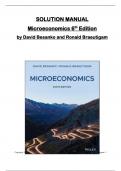Q
SOLUTION MANUAL
Microeconomics 6th Edition
by David Besanko and Ronald Braeutigam
CopyrightQ©Q2014QJohnQWileyQ&QSons,QI ChapterQ1Q-Q
nc. 1
,Chapter 1 Q
Analyzing Economic Problems
Q Q
Solutions to Review Questions
Q Q Q
1. WhatQisQtheQdifferenceQbetweenQmicroeconomicsQandQmacroeconomics?
MicroeconomicsQstudiesQtheQeconomicQbehaviorQofQindividualQeconomicQdecisionQmake
rs,QsuchQasQ aQconsumer,QaQworker,QaQfirm,QorQaQmanager.QQ MacroeconomicsQstudiesQho
wQanQentireQnationalQ economyQperforms,QexaminingQsuchQtopicsQasQtheQaggregateQlevel
sQofQincomeQandQemployment,Q theQlevelsQofQinterestQ ratesQandQprices,QtheQrateQofQinflat
ion,QandQtheQnatureQofQbusinessQcycles.
2. WhyQisQeconomicsQoftenQdescribedQasQtheQscienceQofQconstrainedQchoice?
WhileQourQwantsQforQgoodsQandQservicesQareQunlimited,QtheQresourcesQnecessaryQtoQpro
duceQthoseQ goodsQandQservices,QsuchQasQlabor,QmanagerialQtalent,Qcapital,QandQrawQ m
aterials,QareQ“scarce”Q becauseQtheirQsupplyQisQlimited.QQ ThisQscarcityQimpliesQthatQ weQar
eQconstrainedQ inQtheQchoicesQweQ canQmakeQaboutQwhichQgoodsQandQservicesQtoQproduc
e.QQThus,QeconomicsQisQoftenQdescribedQasQtheQ scienceQofQconstrainedQchoice.
3. HowQdoesQtheQtoolQofQconstrainedQoptimizationQhelpQdecisionQmakersQmake
Qchoices?Q WhatQrolesQdoQtheQobjectiveQfunctionQandQconstraintsQplayQinQaQmodelQ
ofQconstrainedQ optimization?
ConstrainedQoptimizationQallowsQtheQdecisionQmakerQtoQselectQ theQbestQ (optimal)Qaltern
ativeQwhileQ accountingQ forQanyQpossibleQlimitationsQorQrestrictionsQonQtheQchoices.QQ The
QobjectiveQ functionQ representsQtheQrelationshipQtoQ beQmaximizedQorQ minimized.QQ ForQex
ample,QaQfirm’sQprofitQ mightQ beQ theQobjectiveQ functionQandQallQchoicesQwillQbeQevaluate
dQinQtheQprofitQ functionQtoQ determineQwhichQ yieldsQtheQhighestQ profit.QQTheQconstraintsQ
placeQ limitationsQonQtheQchoiceQtheQdecisionQmakerQcanQ selectQ andQdefinesQtheQsetQofQ
alternativesQfromQwhichQtheQbestQ willQbeQchosen.
4. SupposeQtheQmarketQforQwheatQisQcompetitive,QwithQanQupward-
slopingQsupplyQcurve,Q aQdownward-
CopyrightQ©Q2014QJohnQWileyQ&QSons,QI ChapterQ1Q-Q
nc. 2
,slopingQdemandQcurve,QandQanQequilibriumQpriceQofQ$4.00QperQbushel.QWhyQ wouldQ
aQhigherQpriceQ(e.g.,Q$5.00QperQbushel)QnotQbeQanQequilibriumQprice?QWhyQwouldQaQ l
owerQpriceQ(e.g.,Q$2.50QperQbushel)Q notQbeQanQequilibriumQprice?
IfQtheQpriceQ inQtheQ marketQ wasQaboveQtheQequilibriumQprice,QconsumersQwouldQbeQwillin
gQtoQ purchaseQ fewerQunitsQthanQsuppliersQwouldQbeQwillingQtoQ sell,QcreatingQanQexcessQ
supply.QQ AsQ suppliersQrealizeQtheyQareQ notQsellingQtheQ unitsQtheyQhaveQ madeQavailable,Q
sellersQwillQbidQdownQthe
CopyrightQ©Q2014QJohnQWileyQ&QSons,QI ChapterQ1Q-Q
nc. 3
, priceQtoQenticeQ moreQconsumersQtoQ purchaseQtheirQgoodsQorQservices.QQ ByQdefinition,Qeq
uilibriumQisQ aQstateQthatQwillQremainQunchangedQasQlongQasQexogenousQfactorsQremainQu
nchanged.Q SinceQ inQthisQ caseQsuppliersQwillQlowerQtheirQprice,QthisQhighQpriceQcannotQbe
QanQequilibrium.
WhenQtheQpriceQisQbelowQtheQequilibriumQprice,QconsumersQwillQdemandQ moreQunitsQtha
nQsuppliersQ haveQ madeQavailable.QThisQexcessQdemandQwillQenticeQconsumersQtoQbidQu
pQtheQpricesQtoQpurchaseQ theQlimitedQunitsQavailable.QQSinceQtheQpriceQwillQchange,Q itQc
annotQbeQanQequilibrium.
5. WhatQisQtheQdifferenceQbetweenQanQexogenousQvariableQandQanQendogenou
sQvariableQ inQanQeconomicQmodel?QWouldQitQeverQbeQusefulQtoQconstructQaQmodel
QthatQcontainedQonlyQ exogenousQvariablesQ(andQnoQendogenousQvariables)?
ExogenousQvariablesQareQtakenQasQgivenQinQanQeconomicQ model,Q i.e.,QtheyQareQdetermin
edQ byQsomeQ processQoutsideQtheQ model,QwhileQendogenousQvariablesQareQdeterminedQ
withinQtheQeconomicQ modelQbeingQstudied.
AnQeconomicQ modelQthatQcontainedQnoQendogenousQvariablesQwouldQ notQbeQveryQinteres
ting.Q WithQ noQ endogenousQvariables,QnothingQwouldQ beQdeterminedQbyQtheQ modelQsoQitQ
wouldQ notQserveQ muchQ purpose.
6. WhyQdoQeconomistsQdoQcomparativeQstaticsQanalysis?QWhatQroleQdoQen
dogenousQ variablesQandQexogenousQvariablesQplayQinQcomparativeQstaticsQana
lysis?
ComparativeQstaticsQanalysesQareQperformedQtoQ determineQhowQ theQlevelsQofQendogeno
usQvariablesQ changeQasQsomeQexogenousQvariableQ isQchanged.QQ ThisQtypeQofQanalysisQisQ
veryQimportantQsinceQ inQ theQrealQworldQtheQexogenousQvariables,QsuchQasQweather,Qpolic
yQtools,Qetc.QareQalwaysQchangingQ andQ itQ isQusefulQtoQ knowQhowQchangesQinQtheseQvaria
blesQaffectQ theQ levelsQofQother,Qendogenous,Q variables.QQ AnQexampleQofQcomparativeQsta
ticsQanalysisQwouldQ beQaskingQtheQquestion:Q IfQ extraordinarilyQlowQrainfallQ(anQexogenou
sQvariable)QcausesQaQ30QpercentQ reductionQinQcornQsupply,Q byQhowQmuchQwillQtheQ marke
tQ priceQ forQcornQ(anQendogenousQvariable)Q increase?
7. WhatQisQtheQdifferenceQbetweenQpositiveQandQnormativeQanalysis?QWhic
hQofQtheQ followingQquestionsQwouldQentailQpositiveQanalysis,QandQwhichQnorm
ativeQanalysis?
a) WhatQeffectQwillQInternetQauctionQcompaniesQhaveQonQtheQprofitsQofQlocalQa
utomobileQ dealerships?
b) ShouldQtheQgovernmentQimposeQspecialQtaxesQonQsalesQofQmerchandiseQma
CopyrightQ©Q2014QJohnQWileyQ&QSons,QI ChapterQ1Q-Q
nc. 4




